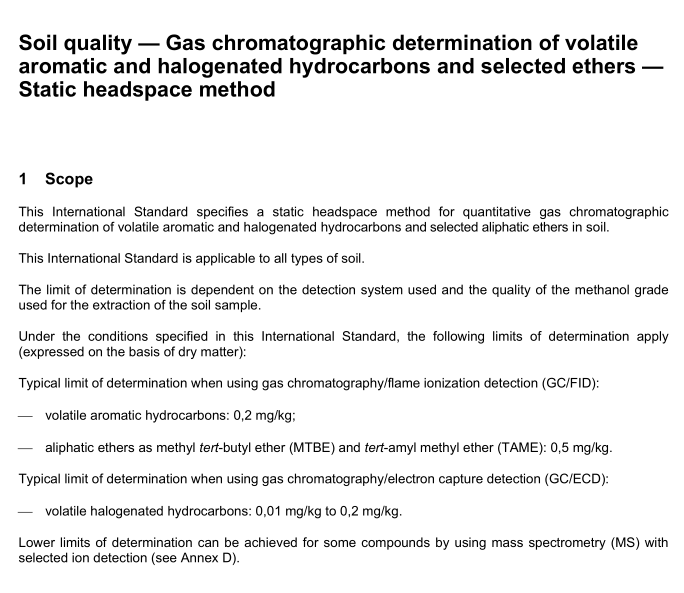ISO 22155 pdf download

ISO 22155 pdf download Soil quality — Gas chromatographic determination of volatile aromatic and halogenated hydrocarbons and selected ethers — Static headspace method
5.4Shaking machine
A shaking machine with horizontal movement (200 to 300 movements per minute).5.5Capillary columns
Fused silica capillary columns with a non-polar or semi-polar stationary phase allowing sufficient separation ofthe compounds of interest. A thick film of stationary phase increases the efficiency of the separation of morevolatile compounds.
Examples are given in 7.4.5.6Gas chromatograph
A gas chromatograph equipped with one or two appropriate detectors. Detectors like flame ionization detector(FID), electron capture detector (ECD), photo ionization detector (PID) or electrolytic conductivity detector(ELCD) and mass spectrometer (MS) can be used, depending on the substances to be analysed and theirtarget level of contamination.The mass spectrometer should be able to operate over the total mass range ofinterest and being equipped with a data system capable of quantifying ions using selected mlz values.
5.7 Electronic integrator or computer with chromatographic software
5.8Syringe, of volume 5 ul,10 ul,50 ul,100 ul, 250 ul and 500 ul
6 Sampling, preservation and sample pretreatment6.1General
Sampling shall be carried out in accordance with ISO 10381-1 using equipment in accordance withlso 10381-2 after coordination with the analytical laboratory.
Samples shall be analysed as soon as possible. Samples shall be stored cool in accordance with IS0 18512.Samples are not pretreated. Exposure of samples to air, even during sampling, shall be avoided as far aspossible.
Sampling for volatile compounds can be carried out with several techniques. It is strongly recommended touse one of the procedures described in 6.2 and 6.3 in order to prevent losses by volatilization.
Determine the dry matter content of the field-moist sample in accordance with ISO11465. In case thesampling method in 6.2 is used, a separate sample should be delivered to the laboratory for determination ofthe dry matter.
6.2Sampling using vials prefilled with methanol
Transfer a defined volume of soil using an appropriate device into a preweighed vial which is filled with adefined volume of methanol (4.6).Prevent leakages by cleaning the top of the vessel before sealing.
The soil samples should be taken from undisturbed material using an appropriate sample cutter of knownvolume,e.g. a modified 20 ml disposable plastic syringe with the tip cut off. The soil sample should becollected immediately after exposing a fresh soil surface of the drilling core, e.g. of an open window sampleror the trial pit wall. The incorporation of material like roots or stones should be avoided as far as possible.
Make sure that the sample is completely covered with methanol (4.6).Then close the cap of the PTFE-coatedseptum. At least one blank sample on every site shall be prepared in the field by opening the prepared vial forthe same time period as necessary for filling with the soil sample. Add methanoi (4.6) and close the cap of thevial.
The sampling vials should be kept dark in a cooler (before and after sampling) throughout the wholetransportation.For details see lsO 18512.
6.3Sampling using coring tube method
This method, by taking an undisturbed sample, greatly reduces or eliminates common losses (e.g. due toevaporation, diffusion, sorption onto plastics). This method involves a stainless-steel coring tube of minimalvolume 200 ml which is filled in situ, retrieved and capped with a non-permeable material, e.g. stainless steel,aluminium foil.The tube should be filled totally.
NOTE This method is not suitable for very stony soils.
Store in cool conditions at a temperature of 2 °C to 8 °C for no longer than 4 d; see lISO18512.
In the laboratory during sub-sampling, take care that no volatile compounds are lost. Start as soon as possiblewith the cooled sampie. Use the whole content of the coring tube or take a sub-sample with a suitableinstrument, e.g. an apple corer, and put it directly into the vial (see 7.2).
7Procedure
7.1Blank determination
For each series of samples, a solvent blank determination shall be carried out by adding 10 ul to 100 ul ofmethanol (4.6) to 5 ml to 10 ml of water (4.1), as is done with a sample. Ensure that no contamination occursfrom the laboratory atmosphere.
7.2Extraction
Using the sampling procedure in 6.2, the extraction is carried out in the field; if using sampling procedure 6.3,the extraction is carried out in the laboratory.
Add a defined amount of test sample (25 g to 50 g), collected as described during sampling (Clause 6) with asampling device into a preweighed vial (50 ml to 100 ml)(see 6.2) filled with a defined amount of methanol(25 ml to 50 ml) and screw-cap the vial with PTFE-coated septum.Weigh and place the vials on the horizontalshaking machine (5.4) and shake for 30 min.
Take the tube out of the shaking machine and allow it to stand for 10 min to 15 min for the settling of solidmaterials. lf there is no settling of solid materials on standing,centrifuge for 10 min at a rotation frequency thatresults in a radial acceleration of 2 000 g.









